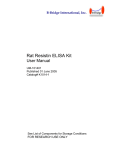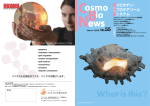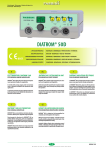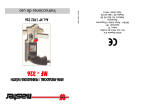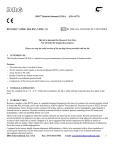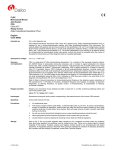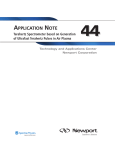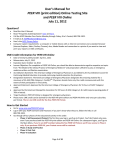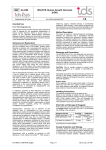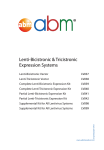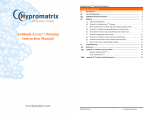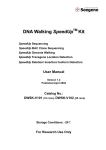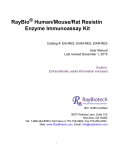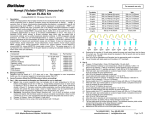Download User Manual
Transcript
RAT RESISTIN ELISA Product Data Sheet Cat. No.: K1014-1-BA For Research Use Only Page 1 of 24 VERSION 17 180908 03 CONTENTS 1. 2. 3. 4. 5. 6. 7. 8. 9. 10. 11. 12. 13. 14. 15. 16. 17. 18. INTENDED USE STORAGE, EXPIRATION INTRODUCTION TEST PRINCIPLE PRECAUTIONS TECHNICAL HINTS REAGENT SUPPLIED MATERIAL REQUIRED BUT NOT SUPPLIED PREPARATION OF REAGENTS PREPARATION OF SAMPLES ASSAY PROCEDURE CALCULATIONS PERFORMANCE CHARACTERISTICS DEFINITION OF THE MASTER STANDARD METHOD COMPARISON TROUBLESHOOTING AND FAQS REFERENCES EXPLANATION OF SYMBOLS 3 3 4 4 5 5 6 6 7 9 10 12 13 15 15 16 17 18 This kit is manufactured by: BioVendor – Laboratorní medicína, a.s. Use only the current version of Product Data Sheet enclosed with the kit! Page 2 of 24 VERSION 17 180908 03 1. INTENDED USE The Rat Resistin ELISA is a sandwich enzyme immunoassay for the quantitative measurement of rat resistin. Features • • • • • • • 2. It is intended for research use only. The total assay time is less than 4 hours. The kit measures total serum (homodimeric) resistin. Assay format is 96 wells. Quality Controls are recombinant rat resistin based. No animal sera are used. Standard is recombinant protein based. Components of the kit are provided ready to use, concentrated or lyophilized. STORAGE, EXPIRATION Store the complete kit at 2-8°C. Under these conditions, the kit is stable until the expiration date (see label on the box). For stability of opened reagents see Chapter 9. Page 3 of 24 VERSION 17 180908 03 3. INTRODUCTION Resistin, a product of the RSTN gene, is a peptide hormone belonging to the class of cysteinerich secreted proteins which is termed the RELM family, and is also described as ADSF (Adipose Tissue-Specific Secretory Factor) and FIZZ3 (Found in Inflammatory Zone). Rat resistin contains 114 amino acids as a prepeptide, and its hydrofobic signal peptide is cleaved before its secretion. Resistin circulates in rat blood as a dimeric protein consisting of two 96 amino acid polypeptides, which are disulfide-linked. Resistin may be an important link between obesity and insulin resistance. Mouse resistin, specifically produced and secreted by adipocyte, acts on skeletal muscle myocytes, hepatocytes and adipocytes themselves so that it reduces their sensitivity to insulin. Steppan et al. have suggested that resistin suppresses the ability of insulin to stimulate glucose uptake. They have also suggested that resistin is present at elevated levels in blood of obese mice, and is down regulated by fasting and antidiabetic drugs (TZDs). On the other hand, several studies demonstrated reduced resistin expression in adipose tissue of obese mice and increased levels in leptin deficient ob/ob mice and Zucker diabetic fatty rats in response to TZDs. Other studies have shown that mouse resistin increases during the differentiation of adipocytes, but it also seems to inhibit adipogenesis. In contrast, the human adipogenic differentiation is likely to be associated with a down regulation of resistin gene expression. Areas of investigation: Insulin resistance Obesity 4. TEST PRINCIPLE In the Rat Resistin ELISA, Standards, Quality Controls and samples are incubated in microplate wells pre-coated with polyclonal anti-rat resistin antibody. After 60 minutes incubation and washing, biotin-labelled polyclonal anti-rat resistin antibody is added and incubated for 60 minutes with captured resistin. After another washing, streptavidin-HRP conjugate is added. After 30 minutes incubation and the last washing step, the remaining conjugate is allowed to react with the substrate solution (TMB). The reaction is stopped by addition of acidic solution and absorbance of the resulting yellow product is measured spectrophotometrically at 450 nm. The absorbance is proportional to the concentration of resistin. A standard curve is constructed by plotting absorbance values against concentrations of Standards, and concentrations of unknown samples are determined using this standard curve Page 4 of 24 VERSION 17 180908 03 5. PRECAUTIONS • For professional use only. • Wear gloves and laboratory coats when handling immunodiagnostic materials. • Do not drink, eat or smoke in the areas where immunodiagnostic materials are being handled. • This kit contains components of animal origin. However, these materials should be handled as potentially infectious. • Avoid contact with the acidic Stop Solution and Substrate Solution, which contains hydrogen peroxide and tetramethylbenzidine (TMB). Wear gloves and eye and clothing protection when handling these reagents. Stop and/or Substrate Solutions may cause skin/eyes irritation. In case of contact with the Stop Solution and the Substrate Solution wash skin/eyes thoroughly with water and seek medical attention, when necessary. • The materials must not be pipetted by mouth. 6. TECHNICAL HINTS • • • • Reagents with different lot numbers should not be mixed. Use thoroughly clean glassware. Use deionized (distilled) water, stored in clean containers. Avoid any contamination among samples and reagents. For this purpose, disposable tips should be used for each sample and reagent. • Substrate Solution should remain colourless until added to the plate. Keep Substrate Solution protected from light. • Stop Solution should remain colourless until added to the plate. The colour developed in the wells will turn from blue to yellow immediately after the addition of the Stop Solution. Wells that are green in colour indicate that the Stop Solution has not mixed thoroughly with the Substrate Solution. • Dispose of consumable materials and unused contents in accordance with applicable national regulatory requirements. Page 5 of 24 VERSION 17 180908 03 7. REAGENT SUPPLIED Kit Components Antibody Coated Microtiter Strips Biotin Labelled Antibody Streptavidin-HRP Conjugate Master Standard Quality Control High Quality Control Low Dilution Buffer Wash Solution Concentrate (10x) Substrate Solution Stop Solution Product Data Sheet + Certificate of Analysis 8. • • • • • • • • • • • State ready to use ready to use ready to use lyophilized lyophilized lyophilized ready to use concentrated ready to use ready to use - Quantity 96 wells 13 ml 13 ml 1 vial 1 vial 1 vial 20 ml 100 ml 13 ml 13 ml 1 pc MATERIAL REQUIRED BUT NOT SUPPLIED Deionized (distilled) water Test tubes for diluting samples Glassware (graduated cylinder and bottle) for Wash Solution (Dilution Buffer) Precision pipettes to deliver 10-1000 μl with disposable tips Multichannel pipette to deliver 100 μl with disposable tips Absorbent material (e.g. paper towels) for blotting the microtitrate plate after washing Vortex mixer Orbital microplate shaker capable of approximately 300 rpm Microplate washer (optional). [Manual washing is possible but not preferable.] Microplate reader with 450 ± 10 nm filter Software package facilitating data generation and analysis (optional) Page 6 of 24 VERSION 17 180908 03 9. PREPARATION OF REAGENTS All reagents need to be brought to room temperature prior to use. Always prepare only the appropriate quantity of reagents for your test. Do not use components after the expiration date marked on their label. • Assay reagents supplied ready to use: Antibody Coated Microtiter Strips Stability and storage: Return the unused strips to the provided aluminium zip-sealed bag with desicant and seal carefully. Remaining Microtiter Strips are stable 3 months stored at 2-8°C and protected from the moisture. Biotin Labelled Antibody Streptavidin-HRP Conjugate Dilution Buffer Substrate Solution Stop Solution Stability and storage: Opened reagents are stable 3 months when stored at 2-8°C. • Assay reagents supplied concentrated or lyophilized: Wash Solution Concentrate (10x) Dilute Wash Solution Concentrate (10x) ten-fold in distilled water to prepare a 1x working solution. Example: 100 ml of Wash Solution Concentrate (10x)+ 900 ml of distilled water for use of all 96-wells. Stability and storage: The diluted Wash Solution is stable 1 month when stored at 2-8°C. Opened Wash Solution Concentrate (10x) is stable 3 months when stored at 2-8°C. Rat Resistin Master Standard Refer to the Cetrificate of Analysis for actual volume of Dilution Buffer needed for reconstitution of standard!!! Reconstitute the lyophilized Master Standard with Dilution Buffer just prior to the assay. Let it dissolve at least 15 minutes with occasionally gently shaking (not to foam). The resulting concentration of the rat resistin in the stock solution is 20 ng/ml. Page 7 of 24 VERSION 17 180908 03 Prepare set of standards using Dilution Buffer as follows: Volume of Standard Stock 500 μl of stock 500 μl of 10 ng/ml 500 μl of 5 ng/ml 500 μl of 2.5 ng/ml 500 μl of 1ng/ml 500 μl of 0.5 ng/ml Dilution Buffer 500 μl 500 μl 500 μl 750 μl 500 μl 500 μl Concentration 20 ng/ml 10 ng/ml 5 ng/ml 2.5 ng/ml 1 ng/ml 0.5 ng/ml 0.25 ng/ml Prepared Standards are ready to use, do not dilute them. Stability and storage: Standard stock solution (20 ng/ml) should be aliquoted and frozen at –20°C for 3 months. Avoid repeated freeze/thaw cycles. Quality Controls High, Low Refer to the Certificate of Analysis for actual volume of Dilution Buffer needed for reconstitution and for current Quality Controls concentrations!!! Reconstitute each Quality Control (High and Low) with Dilution Buffer just prior to the assay. Let it dissolve at least 15 minutes with occasional gentle shaking (not to foam). Reconstituted Quality Controls are ready to use, do not dilute them. Stability and storage: The reconstituted Quality Controls must be used immediately or aliquoted and frozen at -20°C for 3 month. Avoid repeated freeze/thaw cycles. Page 8 of 24 VERSION 17 180908 03 10. PREPARATION OF SAMPLES The kit measures rat resistin in serum. Samples should be assayed immediately after collection or should be stored at -20°C. Mix thoroughly thawed samples just prior to the assay and avoid repeated freeze/thaw cycles, which may cause erroneous results. Avoid using hemolyzed or lipemic samples. Dilute samples 20x with Dilution Buffer just prior to the assay, e.g. 10 μl of sample + 190 μl of Dilution Buffer when assaying samples in singlets, or preferably 15 μl of sample + 285 μl of Dilution Buffer for duplicates. Mix well (not to foam). Vortex is recommended. Stability and storage: Samples should be stored at -20°, or preferably at -70°C for long-term storage. Avoid repeated freeze/ thaw cycles. Do not store the diluted samples. See Chapter 13 for stability of serum samples if stored at 2-8°C, effect of freezing/thawing on the concentration of rat resistin. Note: It is recommended to use a precision pipette and a careful technique to perform the dilution in order to get precise results. Page 9 of 24 VERSION 17 180908 03 11. 1. 2. 3. 4. 5. 6. 7. 8. 9. 10. 11. 12. 13. ASSAY PROCEDURE Pipet 100 μl of prepared Standards, Quality Controls, Dilution Buffer (=Blank) and samples, preferably in duplicates, into the appropriate wells. See Figure 1 for example of work sheet. Incubate the plate at room temperature (ca. 25°C) for 1 hour, shaking at ca. 300 rpm on an orbital microplate shaker. Wash the wells 3-times with Wash Solution (0.35 ml per well). After final wash, invert and tap the plate strongly against paper towel. Add 100 μl of Biotin Labeled Antibody into each well. Incubate the plate at room temperature (ca. 25°C) for 1 hour, shaking at ca. 300 rpm on an orbital microplate shaker. Wash the wells 3-times with Wash Solution (0.35 ml per well). After final wash, invert and tap the plate strongly against paper towel. Add 100 μl of Streptavidin-HRP Conjugate into each well. Incubate the plate at room temperature (ca. 25°C) for 30 minutes, shaking at ca. 300 rpm on an orbital microplate shaker.. Wash the wells 3-times with Wash Solution (0.35 ml per well). After final wash, invert and tap the plate strongly against paper towel. Add 100 μl of Substrate Solution into each well. Avoid exposing the microtiter plate to direct sunlight. Covering the plate with e.g. aluminium foil is recommended. Incubate the plate for 10 minutes at room temperature. The incubation time may be extended [up to 20 minutes] if the reaction temperature is below than 20°C. Do not shake the plate during the incubation. Stop the colour development by adding 100 μl of Stop Solution. Determine the absorbance by reading the plate at 450 nm. The absorbance should be read within 5 minutes following step 12. Note: If the microplate reader is not capable of reading absorbance greater than the absorbance of the highest standard, perform a second reading at 405 nm. A new standard curve, constructed using the values measured at 405 nm, is used to determinerat resistin concentration of off-scale samples. The readings at 405 nm should not replace the on-scale readings at 450 nm. Page 10 of 24 VERSION 17 180908 03 strip 1+2 strip 3+4 strip 5+6 A Standard 20 QC High Sample 7 Sample 15 Sample 23 Sample 31 B Standard 10 QC Low Sample 8 Sample 16 Sample 24 Sample 32 C Standard 5 Sample 1 Sample 9 Sample 17 Sample 25 Sample 33 D Standard 2.5 Sample 2 Sample 10 Sample 18 Sample 26 Sample 34 E Standard 1 Sample 3 Sample 11 Sample 19 Sample 27 Sample 35 F Standard 0.5 Sample 4 Sample 12 Sample 20 Sample 28 Sample 36 G Standard 0.25 Sample 5 Sample 13 Sample 21 Sample 29 Sample 37 H Blank strip 7+8 strip 9+10 strip 11+12 Sample 6 Sample 14 Sample 22 Sample 30 Sample 38 Figure 1: Example of a work sheet. Page 11 of 24 VERSION 17 180908 03 12. CALCULATIONS Most microplate readers perform automatic calculations of analyte concentration. The standard curve is constructed by plotting the mean absorbance at 450 nm (Y) of Standards against log of the known concentration (X) of Standards, using the four-parameter algorithm. Results are reported as concentration of rat resistin ng/ml in samples. Alternatively, the logit log function can be used to linearize the standard curve (i.e. logit of the mean absorbance (Y) is plotted against log of the known concentration (X) of Standards. The measured concentration of samples calculated from the standard curve must be multiplied by their respective dilution factor, because samples have been diluted prior to the assay (e.g. 0.73 ng/ml (from standard curve) x 20 (dilution factor) = 14.6 ng/ml). Rat Resistin ELISA Standard Curve 3,5 3,0 Absorbance (450 nm) 2,5 2,0 1,5 1,0 0,5 0,0 0 1 10 100 Concentration of Rat Resistin(ng/ml) Figure 2: Standard Curve for rat resistin is plotted using the four-parameter function as a proportion of rat resistin concentration and absorbance at 450 nm. Page 12 of 24 VERSION 17 180908 03 13. PERFORMANCE CHARACTERISTICS Typical analytical data of Rat Resistin ELISA are presented in this chapter. • Sensitivity Limit of Detection (LOD) (defined as concentration of analyte giving absorbance higher than mean absorbance of blank* plus three standard deviations of the absorbance of blank: Ablank + 3xSDblank) is calculated from the real resistin values in wells and is 0.05 ng/ml. *Dilution Buffer is pipetted into blank wells. • Limit of assay Results exceeding resistin level of 20 ng/ml should be repeated with more diluted samples. Dilution factor needs to be taken into consideration in calculating the resistin concentration. • Specificity The antibodies used in this ELISA are specific for rat resistin with no detectable crossreactivities to human and mouse recombinant resistin at 50 ng/ml. Sera of several mammalian species were measured in the assay. See results below. Mammalian serum sample Bovine Cat Dog Goat Hamster Horse Monkey Mouse Pig Rabbit Rat Sheep Page 13 of 24 Observed crossreactivity no no no yes yes no no no no no yes no VERSION 17 180908 03 • Precision Intra-assay (Within-Run) (n=8), results are presented after calculation. Sample Mean (ng/ml) 14.07 21.12 1 2 SD (ng/ml) 0.73 1.03 CV (%) 5.2 4.9 Inter assay (Run-to-Run) (n=5), results are presented after calculation. Sample Mean (ng/ml) 18.2 19.3 1 2 SD (ng/ml) 0.91 1.79 CV (%) 4.9 9.3 • Spiking Recovery Serum samples were spiked with different amounts of recombinant rat resistin and assayed. Results are presented after calculation. Sample 1 2 Observed (ng/ml) 14.45 24.03 30.83 40.76 21.12 28.00 38.04 64.50 Expected (ng/ml) 24.45 34.45 44.45 31.12 41.12 71.12 Recovery O/E (%) 98.3 89.5 91.7 90.0 92.5 90.7 • Linearity Serum samples were serially diluted with Dilution Buffer and assayed at a further dilution of 3x. Results are presented after calculation. Sample Dilution 1 2 Page 14 of 24 2x 4x Observed (ng/ml) 28.25 15.89 8.03 Expected (ng/ml) 14.12 7.06 Recovery O/E (%) 112.5 113.7 2x 4x 26.32 15.13 7.21 13.16 6.58 114.9 109.5 VERSION 17 180908 03 • Effect of freezing/thawing No decline was observed in concentration of rat resistin in serum samples after repeated (3x) freezing/thawing cycles. • Stability of samples at 4°C Samples should be stored at –20°C. However, no decline was observed in concentration of rat resistin in serum samples when stored at 4°C for 8 days. To avoid microbial contamination, add NaN3 to a final concentration 0.1% to the samples. • Reference ranges It is recommended that each laboratory include its own panel of control sample in the assay. Each laboratory should establish its own normal and pathological reference ranges for resistin levels with the assay. 14. DEFINITION OF THE MASTER STANDARD A recombinant protein is used as the Master Standard. Resistin concentration depends on the method used for total protein determination. Master Standard in the kit contains 20 ng of resistin measured by Bradford method (Sigma-Aldrich). 15. METHOD COMPARISON Since no competitive commercial test is available, Rat Resistin ELISA has not been compared to any other immunoassay. Page 15 of 24 VERSION 17 180908 03 16. TROUBLESHOOTING AND FAQS Weak signal in all wells Possible explanations: • Omission of a reagent or a step • Improper preparation or storage of a reagent • Assay performed before reagents were allowed to come to room temperature • Improper wavelength when reading absorbance High signal and background in all wells Possible explanations: • Improper or inadequate washing • Overdeveloping; incubation time with Substrate Solution should be decreased before addition of Stop Solution • Incubation temperature over 30°C High coefficient of variation (CV) Possible explanation: • Improper or inadequate washing • Improper mixing Standards, Quality Controls or samples Page 16 of 24 VERSION 17 180908 03 17. REFERENCES References to Rat Resistin ELISA: • Steppan C.M., Lazar M.A.: The current biology of resistin. Journal of Internal Medicine. 255, 439-447, (2004) • Gong H., Ni Y., Guo X., Fei L., Pan X., Guo M., Chen R.: Resistin promotes 3T3-L1 preadipocyte differentiation. Eur J Endocrinol. 150(6):885-92, (2004) • Nogueiras R., Gallego R., Gualillo O., Caminos J.E., Garcia-Caballero T., Casanueva F.F., Dieguez C.: Resistin is expressed in different rat tissues and is regulated in a tissue- and gender-specific manner. FEBS Lett. 31;548(1-3):21-7, (2003) • Satoh H., Nguyen M.T., Miles P.D., Imamura T., Usui I., Olefsky J.M.: Adenovirus-mediated chronic "hyper-resistinemia" leads to in vivo insulin resistance in normal rats. J Clin Invest. 114(2):224-31, (2004) • Pravenec M, Kazdová L, Landa V, Zídek V, Mlejnek P, Jansa P, Wang J, Qi N, Kurtz TW: Transgenic and recombinant resistin impair skeletal muscle glucose metabolism in the spontaneously hypertensive rat. J Biol Chem. 278, 45209-45215, (2003) • Milan G., Granzotto M., Scarda A., Calcagno A., Pagano C., Federspil G., Vettor R.: Resistin and adiponectin expression in visceral fat of obese rats: effect of weight loss. Obes Res. 10(11):1095-103, (2002) • Rajala M.W., Obici S., Scherer P.E., Rossetti L.: Adipose-derived resistin and gut-derived resistin-like molecule-beta selectively impair insulin action on glucose production. J Clin Invest. 111(2):225-30, (2003) • Steppan C.M., Lazar M.A.: Resistin and obesity-associated insulin resistance. TRENDS in Endocrinology and Metabolism. 13 (1), 18-23, (2002) • Banerjee R.R., Lazar M.A.: Dimerization of resistin and resistin–like moleules is determined by a single cystein. The Journal of Biological Chemistry. 276, 25970-25973, (2001) • Kim K.H. et al.: A Cysteine-rich Adipose Tissue-specific Secretory Factors Inhibits Adipocte Differentiation. The Journal of Biological Chemistry. 276 (14), 11252-11256, (2001) • Way J.M. et al.: Adipose Tissue Resistin Expression Is Severly Suppressed in Obesity and Stimulated by Peroxisome Proliferator-activated Receptor γ Agonists. The Journal of Biological Chemistry. 276 (28), 25651-25653, (2001) • Juan CC. at al.: Suppressed Gene Expression of Adipocyte Resistin in an Insulin-resistant Rat Model Probably by Elevated Free Fatty Acids. Biochemical and Biophysical Research Communications. 289, 1328-1333, (2001) • Steppan C.M. at al.: A Family of Tissue-specific Resistin-like Molecules. Proc. Natl. Acad. Sci. USA. 98 (2), 502-506, (2001) • Steppan C.M. et al.: The Hormone Links Obesity to Diabetes. Nature. 409, 307-312, (2001) Page 17 of 24 VERSION 17 180908 03 18. EXPLANATION OF SYMBOLS Catalogue number Content Lot number See instructions for use Biological hazard Expiry date Storage conditions Identification of packaging materials Page 18 of 24 VERSION 17 180908 03 Assay Procedure Summary Antibody Coated Microtiter Strips Reconstitute Master Standard and QCs, prepare set of Standards Dilute Samples 20x Add Standards, QCs and Samples 100 μl Prepare Wash Solution Incubate at RT for 1 hour/300 rpm Wash 3x Add Biotin Labelled Antibody 100 μl Incubate at RT for 1 hour/300 rpm Wash 3x Add Streptavidin-HRP Conjugate 100 μl Incubate at RT for 30 min/300 rpm Wash 3x Add Substrate Solution 100 μl Incubate at RT for 10 min Add Stop Solution 100 μl Read absorbance and calculate results Page 19 of 24 VERSION 17 180908 03 12 11 10 9 8 7 6 5 4 3 2 H G F E D C B A 1 Page 20 of 24 VERSION 17 180908 03 NOTES Page 21 of 24 VERSION 17 180908 03 Page 22 of 24 VERSION 17 180908 03 Page 23 of 24 VERSION 17 180908 03 BioCat GmbH Im Neuenheimer Feld 584 D-69120 Heidelberg Tel.: +49 6221 7141516 Fax: +49 6221 7141529 E-Mail: [email protected] www.biocat.com Page 24 of 24 VERSION 17 180908 03
























